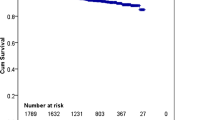Abstract
Background
The occurrence rate of atrial fibrillation (AF) after coronary artery bypass grafting, quoted in the literature, is wide ranging from 5% to over 40%. It is speculated that, off-pump coronary artery bypass grafting (OPCAB) and also minimally invasive cardiac surgery reduces the incidence of postoperative AF due to reduced trauma, ischemia, and inflammation. Current data, however, do not clearly answer the question, whether the incidence of postoperative AF is reduced in using minimally invasive techniques, ideally resulting in the combination of both small access and off-pump surgery. The aim of this study was to evaluate the incidence of postoperative AF in patients undergoing totally endoscopic off-pump coronary artery bypass grafting (TECAB).
Methods
A retrospective analysis of 72 patients undergoing myocardial revascularization was performed. Early postoperative incidence of AF was compared between three groups of patients: 24 after conventional coronary artery bypass grafting (CABG), 24 after OPCAB, and 24 after totally endoscopic off-pump CABG. Clinical profile of the patients, including factors having potential influence on postoperative AF was matched for groups.
Results
Postoperative AF occurred in 25% of the patients in the CABG group, in 16% of the patients in the OPCAB group, and in 16% of the patients in the TECAB group. This difference has no statistical significance. Risk factors and incidence of postoperative complications were comparable in all groups excepting the number of distal anastomoses. There was a statistical significance between CABG group and TECAB group.
Conclusion
Avoiding cardiopulmonary bypass and minimizing surgical trauma did not reduce the incidence of postoperative AF in this patient collective. It remains an attractive hypothesis that postoperative AF is reduced by off-pump myocardial revascularisation and minimizing surgical trauma but more robust data are required.
Similar content being viewed by others
References
Aranki SF, Shaw DP, Adams DH, et al. Predictors of atrial fibrillation after coronary artery surgery: current trends and impact on hospital resources. Circulation 1996;94:390–7
Cohn WE, Sirois CA, Johnson RG. Atrial fibrillation after minimally invasive coronary artery bypass grafting: a retrospective matched study. J Thorac Cardiovasc Surg 1999;66:1068–72
Creswell LL, Schuessler RB, Rosenbloom M, Cox JL. Hazards of postoperative atrial arrhythmias. Ann Thorac Surg 1993;56:539–49
D’mato TA, Savage EB, Wiechmann RJ, et al. Reduced incidence of atrial fibrillation with minimally invasive direct coronary artery bypass. Ann Thorac Surg 2000;70:2013–6
Falk V, Diegeler A, Walther T, Jacobs S, Raumans J, Mohr FW. Total endoscopic off_pump coronary artery bypass grafting. Heart Surg Forum 2000;3(1):29–31
Jideus L, Joachimsson P-O, Stridsberg M, et al. Thoracic epidural anesthesia does not influence the occurrence of postoperative sustained atrial fibrillation. Ann Thorac Surg 2001;72:65–71
Kalman J, Munavar M, Howes LG, et al. Atrial fibrillation after coronary artery bypass grafting is associated with sympathetic activation. Ann Thorac Surg 1995;60:1709–15
Mathew JP, Parks R, Savino JS, et al. Atrial fibrillation following coronary artery bypass graft surgery. Predictors, outcome, and resource utilization. JAMA 1996;276:300–6
Mueller XM, Tevaearai HT, Ruchat P, Stumpe F, Von Segesser LK. Did the introduction of a minimally invasive technique change the incidence of atrial fibrillation after single internal thoracic artery-left anterior descending artery grafting? J Thorac Cardiovasc Surg 2001;121:683–8
Ommen SR, Odell JA, Stanton MS. Atrial arrhythmias after cardiothoracic surgery. NEJM 1997;336:1429–34
Saatvedt K, Fiane AE, Sellevold O, Nordstrand K. Ist atrial fibrillation caused by extracorporal circulation? Ann Thorac Surg 1999;68:931–3
Scherer M, Sirat AS, Aybek T, Martens S, Kessler P, Moritz A. Thoracic epidural anesthesia does not influence the incidence of postoperative atrial fibrillation after beating heart surgery. Thorac Cardiov Surg 2003;51:8–10
Siebert J, Rogowski J, Jagielak D, Anisimowicz L, Lango R, Narkiewicz M. Atrial fibrillation after coronary artery bypass grafting without cardiopulmonary bypass. Eur J Cardio-thorac Surg 2000;17:520–3
Stamou SC, Dangas G, Hill PC, et al. Atrial fibrillation after beating heart surgery. Am J Cardiol 2000;86:64–7
Author information
Authors and Affiliations
Corresponding author
Rights and permissions
About this article
Cite this article
Scherer, M., Sirat, A.S., Dogan, S. et al. Does Totally Endoscopic Access for Off-pump Cardiac Surgery Influence the Incidence of Postoperative Atrial Fibrillation in Coronary Artery Bypass Grafting? A Preliminary Report. Cardiovasc Eng 6, 118–121 (2006). https://doi.org/10.1007/s10558-006-9015-3
Published:
Issue Date:
DOI: https://doi.org/10.1007/s10558-006-9015-3



